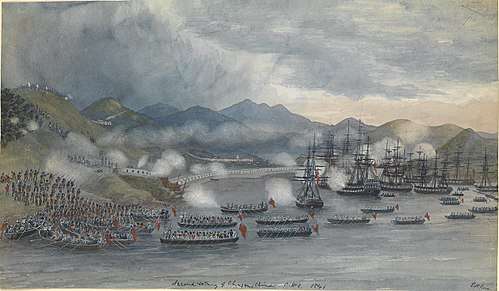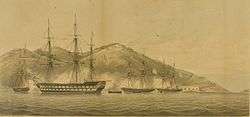Capture of Chusan (1841)
The second capture of Chusan occurred on 1 October 1841 during the First Opium War when British forces captured the city of Dinghai, capital of the Chusan (Zhoushan) islands off the east Chinese coast.
| Second Capture of Chusan | |||||||
|---|---|---|---|---|---|---|---|
| Part of the First Opium War | |||||||
 Second taking of Chusan | |||||||
| |||||||
| Belligerents | |||||||
|
| |||||||
| Commanders and leaders | |||||||
|
Hugh Gough William Parker | Ge Yunfei (KIA)[1] | ||||||
| Strength | |||||||
|
13 ships[2] 2,607 troops[3] | Unknown | ||||||
| Casualties and losses | |||||||
|
2 killed[3] 27 wounded[3] |
1,500 casualties[4] 136 guns captured[5] | ||||||
The fortified city of Dinghai, with a population of 30,000, was defended by the Chinese under the command of Keo. After a brief one-sided seaborne operation involving the 55th Foot, the city fell to the far superior British forces which captured 100 iron guns, 36 brass cannon, and 540 gingalls (heavy muskets or light guns mounted on swivels) for the loss of 2 British killed and 28 wounded.[6][7]
Gallery
 Map of the capture
Map of the capture Attack on the heights of Chusan
Attack on the heights of Chusan
Notes
- MacPherson 1843, p. 216
- MacPherson 1843, pp. 358–359
- MacPherson 1843, p. 374
- MacPherson 1843, p. 217
- MacPherson 1843, p. 375
- China, in a Series of Views, Displaying the Scenery, Architecture ..., Volume 1. p. 92.
- The British Empire, Army Campaigns, Tinghai, September 1841 http://www.britishempire.co.uk/forces/armycampaigns/asia/china/opiumwar.htm
gollark: In CC at least you can set metatables for ALL types.
gollark: Or, well, you can use it for that.
gollark: Pretty much.
gollark: `("bees"):reverse()` → `"seeb"`.
gollark: They implicitly have their own metatable. PotatOS also adds one to numbers, nil, etc.
References
- MacPherson, Duncan (1843). Two Years in China (2nd ed.). London: Saunders and Otley
This article is issued from Wikipedia. The text is licensed under Creative Commons - Attribution - Sharealike. Additional terms may apply for the media files.